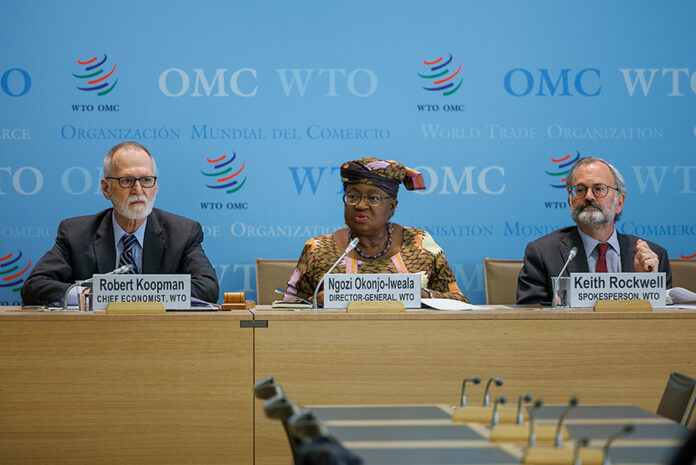
-
The Ukraine conflict threatens fragile global trade recovery, according to WTO
-
World merchandise trade volume should grow 3.0% this year (vs. 4.7% forecast earlier) and 3.4% in 2023, but figures may change due to the war’s uncertain course
-
World GDP at market exchange rates should rise 2.8% after 5.7% in 2021. Output should grow 3.2% in 2023 if geopolitical and economic uncertainty persists
-
Commonwealth of Independent States region should see imports fall 12.0% and GDP slip 7.9% this year, but exports should grow 4.9% as other countries continue to rely on Russian energy
Prospects for the global economy have darkened since the Russian invasion of Ukraine on February 24, prompting economists of the World Trade Organization to reassess their projections for global trade over the next two years.
WTO now expects merchandise trade volume to grow 3.0% in 2022 – slower than its previous forecast of 4.7% – and 3.4% in 2023, but these projections are less certain due to the fluid nature of the conflict.
The war’s most immediate economic impact has been a sharp rise in commodity prices. Despite their small shares in world trade and output, Russia and Ukraine are key suppliers of essential goods including food, energy, and fertilizers. Grain shipments via Black Sea ports have halted, with potentially dire consequences for food security in poor countries.
Lockdowns in China to prevent the spread of COVID-19, meanwhile, are again disrupting seaborne trade just as supply chain pressures appear to be easing. This could lead to renewed shortages of manufacturing inputs and higher inflation.
“The war in Ukraine has created immense human suffering, but it has also damaged the global economy at a critical juncture. Its impact will be felt around the world, particularly in low-income countries, where food accounts for a large fraction of household spending,” WTO Director-General Ngozi Okonjo-Iweala said in a statement.
“Smaller [food] supplies and higher prices … mean the world’s poor could be forced to do without (it). This must not be allowed to happen,” she said, adding more trade is needed. She said restricting trade would threaten the wellbeing of families and businesses and make more fraught the task of building a durable economic recovery from the pandemic.
She urged governments and multilateral groups to work together to facilitate trade amid sharp inflationary pressures on key supplies and growing pressures on supply chains.
With little hard data on the economic impact of the conflict, WTO economists relied on simulations to generate reasonable assumptions about GDP growth in 2022 and 2023.
Estimates based on the WTO Global Trade Model capture 1) the direct impact of the war, including destruction of infrastructure and increased trade costs; 2) the impact of sanctions on Russia, including blocking Russian banks from the SWIFT settlement system; and 3) lower global demand due to falling business/consumer confidence and rising uncertainty.
World GDP at market exchange rates is expected to grow 2.8% this year, down 1.3 percentage points from the previous forecast of 4.1%. Growth should pick up to 3.2% in 2023, near the 3.0% average from 2010 to 2019. Commonwealth of Independent States, which excludes Ukraine, should see output fall to 7.9%, shrinking imports to 12.0%.
Given current GDP assumptions, merchandise trade volume growth in 2022 could be as low as 0.5% or as high as 5.5%. These forecasts will be updated in October, or earlier.
March benchmark Brent crude oil price was US$118 per barrel, up 38% from January and up 81% year-on-year. It peaked at $128/barrel on March 8 but fell to $104 on April 1.
Natural gas prices in Europe rose 45% in January-March to $41.0 per million Btu, but were relatively low in the US at about $4.9/mBtu. Higher oil prices may cut real incomes and import demand worldwide, while higher natural gas prices could hurt Europe more.
The forecast sees 2022 export volume growth of 2.0% for Asia, 3.4% in North America, -0.3% in South America, 2.9% in Europe, 4.9% in the CIS, 1.4% in Africa and 11% in the Middle East. Import growth is seen at 2.0% in Asia, 3.9% in North America, 4.8% in South America, 3.7% in Europe, -12.0% in the CIS, 2.5% in Africa and 11.7% in the Middle East.
Least developed countries should see their export and import volumes rise 3.5% and 6.6% in 2022. Except the Middle East, all regions’ forecasts for 2023 were revised downward.
World trade in commercial services surged 15% year-on-year in 2021, boosted by demand for transport services, which grew 33%. Growth of travel exports was positive but remained weak, as travel restrictions were only partially eased during the year.
Russia is a net services importer, with imports in 2021 valued at US$74 billion and exports at US$55 billion. Before the pandemic, travel/tourism and air transport were Russia’s largest traded services, at 46% of its exports and 36% of imports. These services may be hit hard by sanctions.




